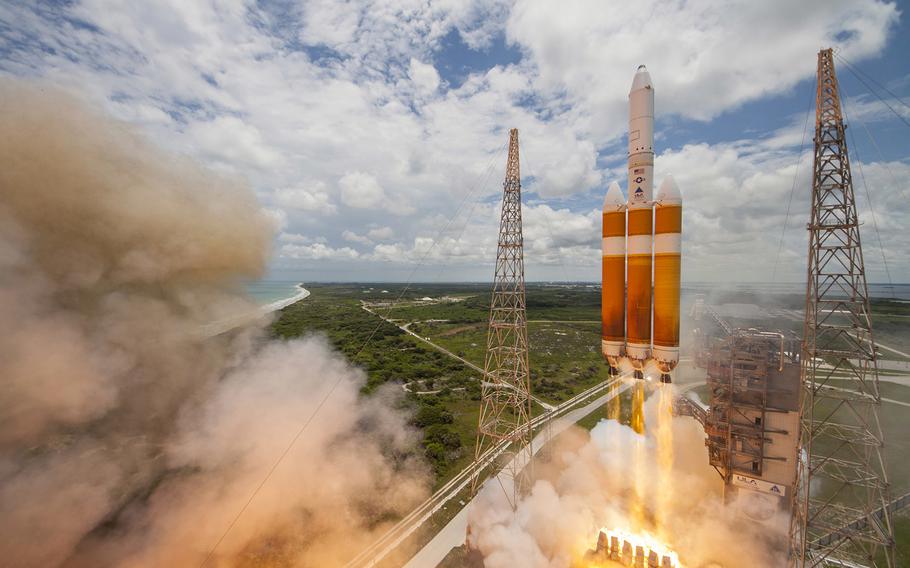
A United Launch Alliance Delta IV-Heavy rocket lifts off from Space Launch Complex 37B at Cape Canaveral Air Force Station, Fla., June 11, 2016, at 1:51 p.m. ET. (United Launch Alliance)
(Tribune News Service) — The Delta family of rockets have been responsible for launching Mars rovers, space telescopes, solar probes, weather satellites and more during a 63-year-run that began when Dwight D. Eisenhower was president.
It has one more to go as United Launch Alliance aims to send up the final Delta IV Heavy rocket on the NROL-70 mission for the National Reconnaissance Office from Cape Canaveral Space Force Station’s Space Launch Complex 37 at 2:45 p.m. Thursday during a window that runs from 1:40 p.m.-5:45 p.m.
Space Launch Delta 45’s weather squadron forecasts only a 30% chance for good conditions Thursday, which improves to 60% if the launch is delayed to Friday and 90% if delayed until Saturday.
“It’s a bittersweet moment for us. This is such an amazing piece of technology,” said ULA President and CEO Tory Bruno. “It’s the most metal of rockets setting itself on fire before it goes to space.”
The way the propellant flows ahead of liftoff gives a massive fireball on the launch pad.
The most powerful version of what has been 389 launch attempts among all Delta rockets has three core boosters powered by cryogenic liquid hydrogen and liquid oxygen that generate more than 2.1 million pounds of thrust on liftoff.
The Delta IV Heavy is making its 16th flight having been introduced in 2004. The medium-lift version of the Delta IV last flew in 2019 while the smaller, older Delta II rocket retired in 2018. The Delta family of rockets along with Atlas V rockets are being replaced by ULA’s new Vulcan Centaur, which made it maiden launch this past January.
This also marks the final ULA launch for SLC 37, which is being considered as a future home for SpaceX Starship and Super Heavy launches.
“Retiring it is obviously the future for a less expensive, higher performance rocket. It’s still sad. However it is an honor for us to serve these missions,” Bruno said.
The first Delta launch attempt came May 13, 1960, from Canaveral’s Space Launch Complex 17. Its design was born from the Thor intermediate-range ballistic missile, and had the capacity to send up 400 pounds of payload to low-Earth orbit. Back then it stood at 90 feet tall and weighed 112,000 pounds generating only 150,000 pounds of thrust at liftoff.
Among its payloads over the years, Delta rockets have launched NASA’s Pioneer and Explorer spacecraft, the first Mars rover Sojourner on the Pathfinder mission plus twin rovers Spirit and Opportunity, the Dawn mission that visited Ceres and Vesta and the Deep Impact that slammed into the comet Tempel 1.
They have launched the Spitzer and Kepler space telescopes, Parker Solar Probe, the NOAA’s GOES satellites and dozens of GPS satellites.
While many Delta IV Heavy flights have been classified missions for the military, it was also the rocket that sent up the first Orion spacecraft on its test flight back in 2014 on the EFT-1 mission, a precursor to the Artemis missions on which Orion now flies.
The last Delta IV Heavy mission is classified again, an NRO satellite that will “strengthen the NRO’s ability to provide a wide-range of timely intelligence information to national decision makers, warfighters, and intelligence analysts to protect the nation’s vital interests and support humanitarian efforts worldwide.”
The launch is the 21st from the Space Coast in 2024, but only the second for ULA after the Vulcan launch in January. The company flew only three times in 2023 while competitor SpaceX racked up 98 orbital launches across its Florida and California launch pads.
The coming years, though, promise to get busier for ULA.
ULA still has 17 more Atlas V rockets in its stable including seven set aside for the Boeing CST-100 Starliner missions to bring crew to the International Space Station. The first test flight with humans on board is slated for as early as May 1 with operational missions that could fly once a year from 2025-2030. Another eight Atlas V rockets are set aside to fly up satellites for Amazon’s Project Kuiper internet constellation. The other two Atlas V missions are set aside for its final Space Force flight later this year and a private communications satellite in 2025.
Meanwhile, ULA is ramping up Vulcan Centaur hardware with its next mission as early as this summer to fly Sierra Space’s Dream Chaser cargo spacecraft to the ISS. That also acts as the second certification flight for Vulcan that then opens up a slew of Space Force missions on its plate.
“All of the hardware that I’m building right now in my supply chain and in the factory where I’ve got four or five boosters in flow … are good to go,” Bruno said.
He said the goal is get to launches from the Cape of once every two weeks.
“We are literally building ahead so we can build up inventory and then come on into that as infrastructure comes on line,” he said. Here at the Cape, the most important and visible thing is a whole other Vertical Integration Facility … the bottleneck is integrating the rockets. So now there’ll be two lanes, so we’ll be building two rockets all the time simultaneously.”
A big chunk of those are dozens more launches for Project Kuiper that have to fly before 2026.
“We’re feeling pretty good about the ramp up. Big challenge,” Bruno said. “I’m not going to BS you, it will be tight in ’24 and into ’25, the first half, but we are on track, we’re pretty confident we’ll hit that tempo when we need to late next year.”
©2024 Orlando Sentinel.
Visit orlandosentinel.com.
Distributed by Tribune Content Agency, LLC.